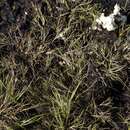Comments
provided by eFloras
Although placed by K. K. Mackenzie (1931–1933, parts 2–3, pp. 231–231) in sect. Bicolores Tuckerman, Carex rufina is a member of the C. acuta complex, and appears to be very closely related to C. lenticularis. It differs from C. lenticularis in the red-brown spotted perigynia, black scales, and gynecandrous terminal spike.
- license
- cc-by-nc-sa-3.0
- copyright
- Missouri Botanical Garden, 4344 Shaw Boulevard, St. Louis, MO, 63110 USA
Description
provided by eFloras
Plants cespitose. Culms obtusely angled, 4–15 cm, glabrous. Leaves: basal sheaths red-brown; sheaths of proximal leaves glabrous, fronts with red-brown spots, veinless, apex U-shaped; blades amphistomic, 1.5–2 mm wide, papillose on both surfaces. Inflorescences: proximal bract longer than inflorescence, 1–1.5 mm wide. Spikes erect, compact; proximal 2–3 spikes pistillate, 1–1.5 cm × 3 mm, base cuneate; terminal spike gynecandrous. Pistillate scales red-brown or black, shorter than perigynia, apex obtuse, awnless. Perigynia ascending, green (becoming white) with red-brown spots on apical 1/2, 3–5-veined on each face, stipitate, tightly enclosing achenes, thin-walled, ellipsoid, 2–2.2 × 1.2–1.5 mm, dull, base truncate, distended, apex obtuse or acute, papillose apically; stipe to 0.3 mm; beak red-brown, 0.2 mm. Achenes not constricted, dull, base adnate to perigynium. 2n = 86.
- license
- cc-by-nc-sa-3.0
- copyright
- Missouri Botanical Garden, 4344 Shaw Boulevard, St. Louis, MO, 63110 USA
Distribution
provided by eFloras
Greenland; Man., Nunavut, Que.; Europe (Denmark, Norway, Sweden).
- license
- cc-by-nc-sa-3.0
- copyright
- Missouri Botanical Garden, 4344 Shaw Boulevard, St. Louis, MO, 63110 USA
Habitat
provided by eFloras
Wet sandy or gravelly shores; 0–800m.
- license
- cc-by-nc-sa-3.0
- copyright
- Missouri Botanical Garden, 4344 Shaw Boulevard, St. Louis, MO, 63110 USA
Comprehensive Description
provided by North American Flora
Carex rufina Drejer, Nat. Tidssk. 3: 446. 1841
Loosely cespitose, the rootstocks slender, brownish, scaly, ascending obliquely, sparingly branching above, the culms few together, 2-8 cm. high, slender, often curved, compressedtriangular, smooth, not papillate, much shorter than the leaves, brownish at base, strongly phyllopodic, the dried-up leaves of the previous year conspicuous; sterile shoots conspicuous, aphyllopodic, lateral; leaves of the flowering year with well-developed blades 4-6 to a flowering culm, on lower three fourths, not septate-nodulose, the blades 1-8 cm. long, 0.5-1.5 mm. wide, flat above, channeled towards base, soft, yellowish-green, short-attenuate, sparingly roughened at apex only, the sheaths rather loose, smooth, whitish ventrally, truncate at mouth, the ligule wider than long; spikes 3 or 4 (rarely 5), erect, approximate and subsessile, or the lowest more or less remote and peduncled, the terminal gynaecandrous (rarely entirely staminate), the lateral entirely pistillate, short-oblong to oblong, 6-10 mm. long, 4.5 mm. wide, densely flowered, the perigynia 8-20, appressed-erect in several rows; lowest 1 or 2 bracts leaf-like, biauriculate, exceeding culm, short-sheathing and dark-reddish-brown-tinged at base; upper bracts squamiform, much reduced; scales closely appressed, obovate, obtuse, as wide as and slightly shorter than perigynia, shining, purplish-brown, with lighter midvein or center not extending to apex; perigynia obovoid, 2-2.5 mm. long, 1.5 mm. wide, very strongly flattened, unequally biconvex, the marginal perigynia 2-ribbed, all obsoletely very slenderly nerved, light-green or yellowish-green or somewhat glaucous-green, puncticulate, glabrous, the upper margin sparingly serrulate, round-truncate at base, stipitate, abruptly apiculate, the beak 0.1-0.2 mm. long, slightly emarginate, purple-tinged; achenes lenticular, closely enveloped, filling lower three fourths of perigynium, ovoid-orbicular, 1.25-1.5 mm. long, nearly as wide, yellowish-brown, puncticulate, sessile, apiculate, jointed with the short, slender, included style; stigmas two, slender, short.
TvPE ixjcalitv: "In locis irrigatis glareosis ad limilem maris orae oricntalis Groenlandiae (60° — 60° 28'J: etiam in sinu Godlhaab alt. circitcr 300' supra mare legit J. Vahl." (Fl. Dan.) Distribution: High northern sections of Greenland, Lapland and Norway. (Specimens examined from Greenland.)
- bibliographic citation
- Kenneth Kent Mackenzie. 1935. (POALES); CYPERACEAE; CARICEAE. North American flora. vol 18(4). New York Botanical Garden, New York, NY
Carex rufina: Brief Summary
provided by wikipedia EN
Carex rufina is a species of sedge known by the common name snowbed sedge. It is native to Denmark, Norway, Sweden, Greenland, and northeastern Canada.
This species is a perennial herb growing up to 15 centimetres (6 in) tall. It has sheathed, grasslike leaves no more than 2 millimetres (0.08 in) wide. The lower spikes are female, while the terminal spike is gynecandrous. This inflorescence is often hidden in the leaves, which form a dense tussock. The species often reproduces clonally.
This sedge grows in alpine snowbed habitat. This ecosystem is sensitive to climate change, which causes a rise in the local temperatures and a loss of moisture in the normally wet substrates. Elimination of patches of snowbed causes habitat fragmentation. Drying and changes in the floral composition of the habitat make it less hospitable to the sedge. It has declined, leading to its listing as a near-threatened species in Norway.
- license
- cc-by-sa-3.0
- copyright
- Wikipedia authors and editors

